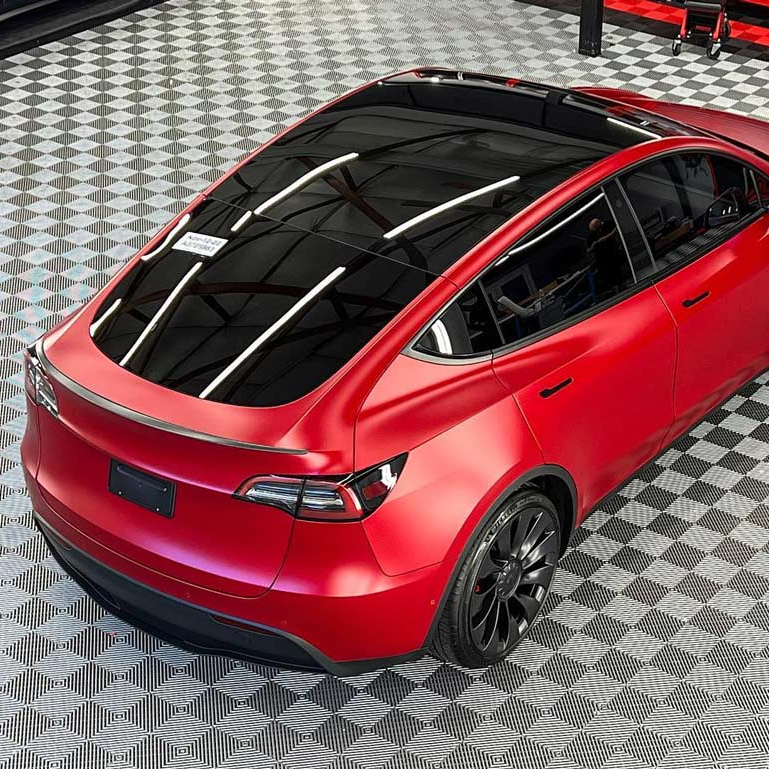Are you operating your vehicle with a window tint that has reached its peak? Similar to a beloved pair of sunglasses, auto window tints can deteriorate and lose their appeal over time. You may not see it at first, but signs like bubbling or fading can affect how well your car protects you from the sun and keeps the interior cool. After investing significant time and effort into achieving the ideal tint, it's crucial to monitor its condition. So, let's find out if it's time to give your windows some TLC!
You can determine if your
auto window tint is losing its effectiveness by checking for common signs such as bubbling or air bulges, purpling and fading of color, curling or peeling edges, scratches and gouges, and a noticeable increase in interior heat or sunlight entering the vehicle. If you observe any of these indicators, it may be time to consult a professional for replacement services to maintain comfort and UV protection in your vehicle.

Signs Your Auto Window Tint is Deteriorating
Bubbling and Air Bulges
One of the most noticeable indicators of aging window tint is the presence of bubbles or air pockets beneath the film. When this occurs, it's a clear signal that the adhesive used to attach the tint to the glass is failing. Small bubbles can distort visibility and create unsafe driving conditions. Imagine cruising down the highway and suddenly noticing an obstructed view—this can happen with just a few small bubbles. Larger bubbles not only look unappealing but can severely diminish the overall effectiveness of the tint in blocking harmful UV rays and heat.
Fading and Discoloration
Another critical sign to watch for is fading. According to research by the International Window Film Association, lower-quality tints may start fading within 2–3 years after installation. If you've noticed your once vibrant, dark tint morph into a faded purplish hue, it's likely due to UV damage, which compromises its ability to protect against sun exposure. Continuing neglect of this issue can lead you to miss out on valuable insulation against heat and UV rays.
Peeling and Curling
Watch out for peeling or curling edges. This deterioration often occurs when the adhesive weakens due to prolonged exposure to heat, sunlight, or improper installation techniques. Peeling edges are not just unattractive; they indicate ongoing issues that could lead to further degradation of your window tint if left unattended.
Scratches and Gouges
Everyday life can wreak havoc on your window tint over time. Activities involving moving large objects in and out of your vehicle might lead to scratches and gouges on the film's surface. These imperfections reduce the aesthetic appeal of your vehicle while also impeding the film’s effectiveness, allowing more sunlight in and diminishing its protective capabilities.
Understanding these signs is crucial, as they pave the way for identifying underlying factors that contribute to such deterioration in window tint films.
Causes of Tint Effectiveness Loss
Multiple factors contribute to the degradation of window tint, and being aware of them can help you make informed decisions about maintenance and replacement.
One of the most significant contributors is sunlight and UV exposure. Constant exposure to UV rays not only affects the appearance of your tint but also breaks down the chemical compounds in the film. Over time, this leads to noticeable fading and a reduced ability to block sunlight, leaving your vehicle's interior vulnerable to harmful ultraviolet radiation.
Poor Quality Material
Another critical factor is the quality of the tint material itself. Lower-quality films often lack the necessary resilience to withstand environmental stressors like intense heat, cold, and moisture. These inferior materials can begin to show signs of deterioration within just a few years. When you opt for subpar products, you're effectively inviting problems that could have been avoided with a more reliable choice. Investing in high-quality tint ensures longer-lasting results; it's one of those rare cases where you truly get what you pay for.
Improper Installation
Additionally, improper installation can wreak havoc on your window tint's longevity. Wrinkles, bubbles, and peeling are all direct outcomes of a rushed or careless job during installation. It’s crucial to ensure that your tint is applied by professionals who are trained and experienced in their craft. Not only does the installation enhance the aesthetic appeal of your vehicle, but it also significantly boosts the lifespan of your tint, protecting your investment.
It's remarkable how proactive maintenance of your vehicle's windows can yield significant benefits.
Furthermore, temperature fluctuations play an undeniable role in the overall deterioration process. Extreme temperature changes can lead to micro-cracks in the film as it expands and contracts. Research shows that temperatures above 180°F (82°C) can significantly weaken the film's integrity.
Recognizing how these elements interact will better equip you to maintain your window tints’ functionality and aesthetics over time. Knowledge truly is power, especially when it comes to preserving the benefits that window tinting provides for safety and comfort in your vehicle.
With a clear understanding of these causes, it's essential to assess how well your tint is currently performing.

Evaluating Tint Performance
Begin by testing visibility, one of the most important aspects of evaluating your tint's condition. Find a brightly lit area and park your car. From inside, take a moment to look through your windows closely. Is the view still sharp and clear? Ideally, clarity should be consistent across all windows. If you notice any significant blurriness or discoloration, it may be an indicator that your tint is degrading and needs replacement.
Assessing your tint's ability to withstand heat is a logical next step, as it plays a crucial role in providing comfort during those scorching summer days.
Heat Rejection Test
To conduct a heat rejection test, grab a thermometer or any available temperature measuring tool. Before getting into the car, measure the interior temperature when parked under sunlight exposure and then again when you're in the shade. A quality window tint can significantly reduce the heat indoors, making it more comfortable for both drivers and passengers. If you don’t observe a noticeable difference between the two temperatures, it suggests that your current film might not be functioning as intended.
Taking our evaluation a step further involves protecting your skin from harmful rays.
UV Meter Test
Another effective way to gauge your tint's protective capabilities is to invest in an inexpensive UV meter. These handy devices can measure how much ultraviolet radiation passes through your windows. By conducting this quick assessment, you'll get a clearer picture of whether your tint is living up to its claim, especially if you're often driving on sun-drenched roads. Remember, modern window films can block up to 99% of harmful UV rays, so if you consistently find high levels of UV penetrating your tint, it’s time to consider an upgrade.
Assessing the effectiveness of your window tint is vital for enjoyment and protection while driving. Regular checks help ensure that your investment stands up against the elements—a wise choice considering how advanced technologies continue to make significant improvements in automotive window films today.
Prolonging the Life of Your Window Tint
Adopting ongoing cleaning and maintenance practices is one of the best ways to ensure that your window tint remains effective and protects its integrity over time. Understanding each step will help keep your tinted windows looking sharp and functioning optimally for as long as possible.
Gentle Cleaning Practices
When it comes to cleaning tinted windows, gentleness is key. Using a soft microfiber cloth paired with a mild, ammonia-free cleaner can do wonders without jeopardizing the tint film itself. Ammonia can degrade the adhesive and color of the tint, which is why avoiding harsh chemicals is crucial.
After cleaning, ensure that all edges are free from dirt and grime, as these can compromise the bond between the glass and the film. If there are stubborn spots, take a little extra time to address them rather than scrubbing harshly, which may lead to scratches or bubbles forming over time.
Regular Maintenance Checks
It's wise to conduct monthly inspections to catch any potential issues early. Here’s what to look for:
- Check for bubbling and peeling at the edges that may indicate an adhesive failure.
- Clean any accumulated dirt and grime from around the edges so they don’t get stuck under the film when rolling down windows.
- After washing your vehicle or in rainstorms, ensure that you thoroughly dry the windows—moisture trapped under the film could lead to mold or other complications.
A study by Consumer Reports indicates that regular maintenance can extend a window tint’s life by up to 50%. This shows significant benefits in being proactive about preserving your investment.
Among car enthusiasts, maintaining their vehicles is an unbeatable passion, and window tint should not be overlooked. Just like how you wouldn’t ignore checking tire pressure or oil levels, injecting regular checks into your schedule will greatly enhance both aesthetic appeal and functional benefits.
Implementing these practices not only extends the lifespan of your window tint but also enhances its functionality. As we shift our focus now, let's explore how selecting superior-quality materials can further boost durability and performance.
Investing time to research high-quality tint film can make all the difference in maintaining your vehicle’s charm while maximizing comfort. By understanding both the benefits of ceramic versus carbon tints and ensuring you choose a product backed by a solid warranty, you'll be making a smart investment in style and practicality.
In making this choice today, you ensure your car remains cool and visually appealing for years to come. For more information or assistance with your window tinting needs, feel free to reach out to
Superior Auto Shine or call us at (253) 260-6868.

